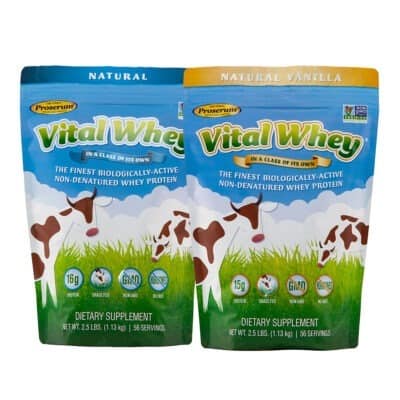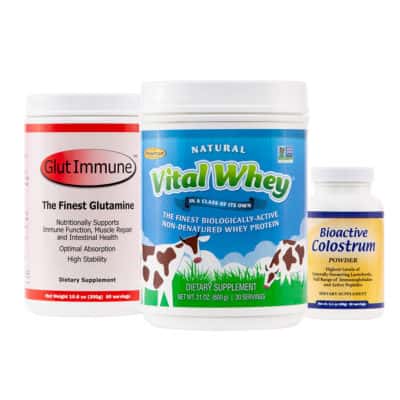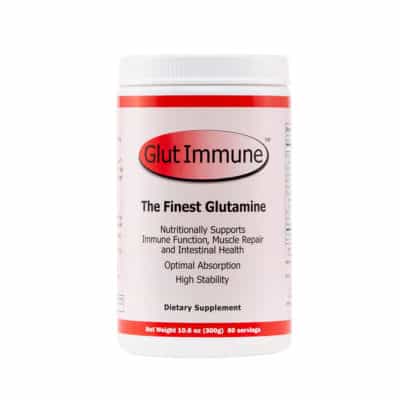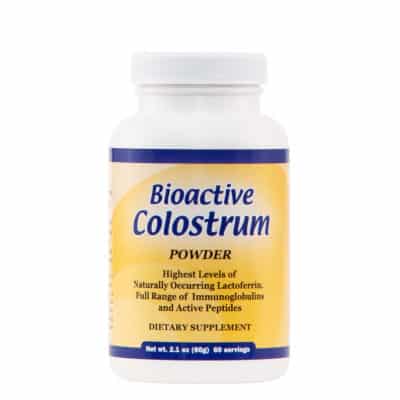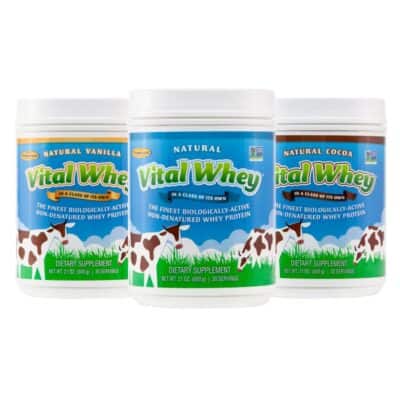The paleo diet is an unprocessed, or whole food, diet. Many people choose to go paleo and end up loving the way they feel when they eat primarily high-quality proteins, healthy fats, vegetables, and fruit.
There are plenty of paleo-friendly protein foods, including grass-fed red meat, free range chicken, and pastured eggs. If you’re trying to get more protein in your diet, you may be wondering if you can add protein powder to your paleo meal plans.
In this article, we’ll answer the following questions:
- Are protein powders paleo friendly?
- Is whey protein allowed on the paleo diet?
- Is grass-fed whey protein paleo?
- What’s the best protein powder to use on a paleo diet?
Whey Protein and Paleo Diet: What You Need to Know
To understand whether you can have whey protein on a paleo diet, it helps to revisit the basics of the paleo diet.
The rules of the paleo diet state that you should only eat the things that your caveman ancestors would have eaten for optimal health. That means the paleo diet includes minimally processed foods that were once hunted or gathered and eliminates foods that are a result of modern agriculture.
Foods allowed on a paleo diet include:
- Fruit
- Nuts
- Pastured meats, poultry, and eggs
- Seafood
- Seeds
- Vegetables
Foods you can not eat include:
- Artificial sweeteners
- Dairy products
- Grains, including wheat, oats, and rice
- Legumes, including beans and soy products
- Processed foods
- Sugars
- Vegetable oils
Based on these paleo diet rules, protein powders are not paleo friendly. Whey protein is not paleo because:
- It comes from dairy. Whey is one of two main proteins found in dairy products, which you are not supposed to consume on the paleo diet.
- It’s processed. To produce protein powder, whey is extracted from dairy, dried, and turned into a powder. This is processing, which doesn’t comply with the rules of the paleo diet.
The paleo diet is meant to encourage you to make healthier eating choices, not restrict your diet completely. High-quality whey protein offers several health benefits and many people use it to support a healthy lifestyle. Should you be allowed to combine paleo and whey protein?
Pros and Cons of Whey Protein for Paleo Diet
Whey protein may not fit the paleo diet rules, but that doesn’t mean everyone following the paleo diet needs to avoid it.
Here are some reasons to consider taking protein powder:
1) Whey protein supports muscle growth.
If you are pushing your body hard at the gym every day, you’ll find that adding whey protein to your diet can help you build and repair muscles. Athletes with rigorous training schedules require more protein than regular dieters, so including protein powder can be a smart way to fuel your body.
2) Whey protein is convenient and portable.
When it comes to building muscle and bulking up, the timing of your nutrition is very important. Eating before your workouts is critical for having energy to power your workouts and eating after can aid muscle recovery and promote speedier post-workout recovery.
Although there are plenty of protein-rich foods allowed on the paleo diet, not all of them offer convenience or portability like protein powder. You may not always have time to cook around your workouts, but whey protein powder makes it quick and easy for you to get all of the amino acids your body needs to build muscle.
3) Whey protein promotes satiety.
Whey protein can help you feel fuller for longer. Food cravings and hunger between meals can make it harder to make healthy choices or stick to weight loss goals. Protein powder can be a good way to pump up the protein content of a meal or get extra protein between meals to keep hunger under control.
4) Whey protein is versatile.
You aren’t limited to using whey protein in protein shakes. It can be used in a variety of recipes, including smoothies, coffee drinks, flourless waffles or pancakes, and grain-free desserts.
There aren’t many cons to including whey protein on a paleo diet. Whey protein may not be right for your paleo diet if:
1) You’re sensitive to dairy.
Whey protein may contain traces of lactose, so individuals who are very sensitive to dairy may not tolerate it well.
2) You just started the paleo diet.
The first 30 days of the paleo diet can feel pretty strict as you get accustomed to the new diet. It may be easier to put whey protein on hold during this time to see how you feel on a true paleo diet.
Once you have gone paleo for a few months, it may be a good idea to try adding whey protein to your diet for the benefits mentioned above.
If you’re not sensitive to dairy or whey and your diet is otherwise nutritious, you should consider carefully whether whey protein belongs in your diet!
Tips for Using Whey Protein with Paleo Diet
There’s no such thing as paleo whey protein. If you are going to break the “laws of paleo” and add whey protein to your diet, here are a few tips to help you choose a high-quality protein powder:
1) Choose whey from grass-fed cows.
You’ll get quality amino acids without chemicals and additives in whey protein made from low quality milk.
2) Choose whey concentrate.
Whey protein concentrate is much easier for your body to absorb compared to whey protein isolate.
3) Look for minimal ingredients.
If a protein powder is filled with a bunch of ingredients you don’t recognize, those are additives and not quality ingredients. Always read the label and research any ingredients you’re not sure about.
Our Well Wisdom Whey Protein meets all these criteria, making it a high quality protein powder to include on your paleo diet.
Bottom Line
Whey protein is technically not paleo friendly. However, many hardcore paleo dieters give whey protein a pass because it’s nutritious, helps them build muscle, and is a beneficial addition to their diet. Only you can determine if the benefits of using whey protein make sense for your paleo diet.
If you want to combine whey protein and the paleo diet, choosing a high-quality whey protein with minimal ingredients is the best way to stick as closely as possible to the paleo diet rules.
References
- Persistent Tiredness and Chronic Fatigue: Causes and Symptoms - February 27, 2024
- Can A Protein Shake Replace A Breakfast Meal? - March 2, 2023
- Glutamine After Surgery: Does It Help With Recovery? - February 17, 2023


